An official website of the United States government
 United States Department of Labor
United States Department of Labor
Perform nonroutine or precision functions involving the preparation of large portions of meat. Work may include specialized slaughtering tasks, cutting standard or premium cuts of meat for marketing, making sausage, or wrapping meats. Work typically occurs in slaughtering, meat packing, or wholesale establishments. Excludes “Meat, Poultry, and Fish Cutters and Trimmers” (51-3022) who perform routine meat cutting.
Employment estimate and mean wage estimates for Slaughterers and Meat Packers:
| Employment (1) | Employment RSE (3) |
Mean hourly wage |
Mean annual wage (2) |
Wage RSE (3) |
|---|---|---|---|---|
| 86,450 | 1.6 % | $ 15.39 | $ 32,010 | 0.3 % |
Percentile wage estimates for Slaughterers and Meat Packers:
| Percentile | 10% | 25% | 50% (Median) |
75% | 90% |
|---|---|---|---|---|---|
| Hourly Wage | $ 11.42 | $ 13.99 | $ 14.38 | $ 17.73 | $ 18.18 |
| Annual Wage (2) | $ 23,750 | $ 29,090 | $ 29,900 | $ 36,870 | $ 37,820 |
Industries with the highest published employment and wages for Slaughterers and Meat Packers are provided. For a list of all industries with employment in Slaughterers and Meat Packers, see the Create Customized Tables function.
Industries with the highest levels of employment in Slaughterers and Meat Packers:
| Industry | Employment (1) | Percent of industry employment | Hourly mean wage | Annual mean wage (2) |
|---|---|---|---|---|
| Animal Slaughtering and Processing | 78,500 | 15.08 | $ 15.46 | $ 32,160 |
| Food and Beverage Stores (4451 and 4452 only) | 2,250 | 0.08 | $ 14.41 | $ 29,970 |
| Merchant Wholesalers, Nondurable Goods (4244 and 4248 only) | 1,700 | 0.18 | $ 15.49 | $ 32,220 |
| Animal Food Manufacturing | 70 | 0.11 | $ 15.47 | $ 32,190 |
| Other Food Manufacturing | 50 | 0.02 | $ 15.07 | $ 31,340 |
Industries with the highest concentration of employment in Slaughterers and Meat Packers:
| Industry | Employment (1) | Percent of industry employment | Hourly mean wage | Annual mean wage (2) |
|---|---|---|---|---|
| Animal Slaughtering and Processing | 78,500 | 15.08 | $ 15.46 | $ 32,160 |
| Merchant Wholesalers, Nondurable Goods (4244 and 4248 only) | 1,700 | 0.18 | $ 15.49 | $ 32,220 |
| Animal Food Manufacturing | 70 | 0.11 | $ 15.47 | $ 32,190 |
| Food and Beverage Stores (4451 and 4452 only) | 2,250 | 0.08 | $ 14.41 | $ 29,970 |
| Other Food Manufacturing | 50 | 0.02 | $ 15.07 | $ 31,340 |
Top paying industries for Slaughterers and Meat Packers:
| Industry | Employment (1) | Percent of industry employment | Hourly mean wage | Annual mean wage (2) |
|---|---|---|---|---|
| Merchant Wholesalers, Nondurable Goods (4244 and 4248 only) | 1,700 | 0.18 | $ 15.49 | $ 32,220 |
| Animal Food Manufacturing | 70 | 0.11 | $ 15.47 | $ 32,190 |
| Animal Slaughtering and Processing | 78,500 | 15.08 | $ 15.46 | $ 32,160 |
| Other Food Manufacturing | 50 | 0.02 | $ 15.07 | $ 31,340 |
| Food and Beverage Stores (4451 and 4452 only) | 2,250 | 0.08 | $ 14.41 | $ 29,970 |
States and areas with the highest published employment, location quotients, and wages for Slaughterers and Meat Packers are provided. For a list of all areas with employment in Slaughterers and Meat Packers, see the Create Customized Tables function.
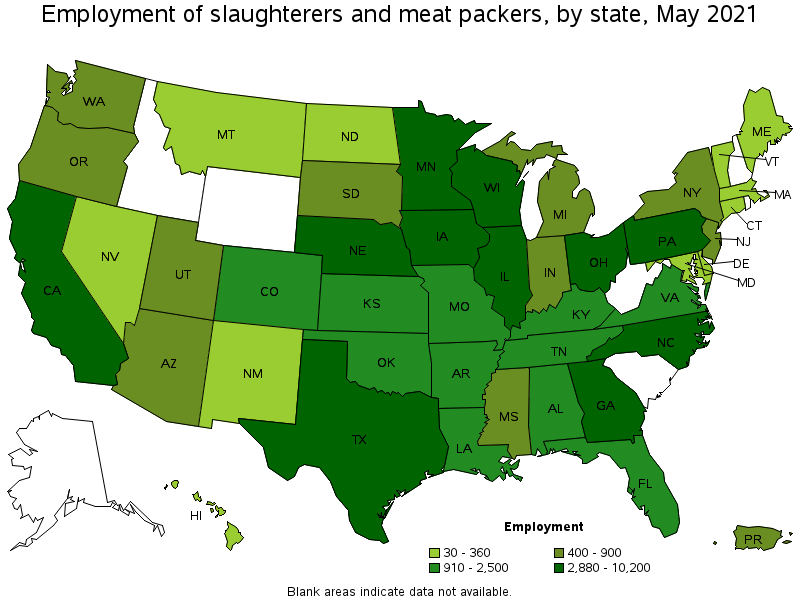
States with the highest employment level in Slaughterers and Meat Packers:
| State | Employment (1) | Employment per thousand jobs | Location quotient (9) | Hourly mean wage | Annual mean wage (2) |
|---|---|---|---|---|---|
| North Carolina | 10,200 | 2.31 | 3.76 | $ 15.45 | $ 32,130 |
| Texas | 8,530 | 0.70 | 1.14 | $ 15.79 | $ 32,840 |
| Minnesota | 6,860 | 2.51 | 4.09 | $ 15.90 | $ 33,080 |
| Iowa | 6,550 | 4.41 | 7.19 | $ 16.89 | $ 35,140 |
| California | 6,370 | 0.39 | 0.63 | $ 15.27 | $ 31,760 |
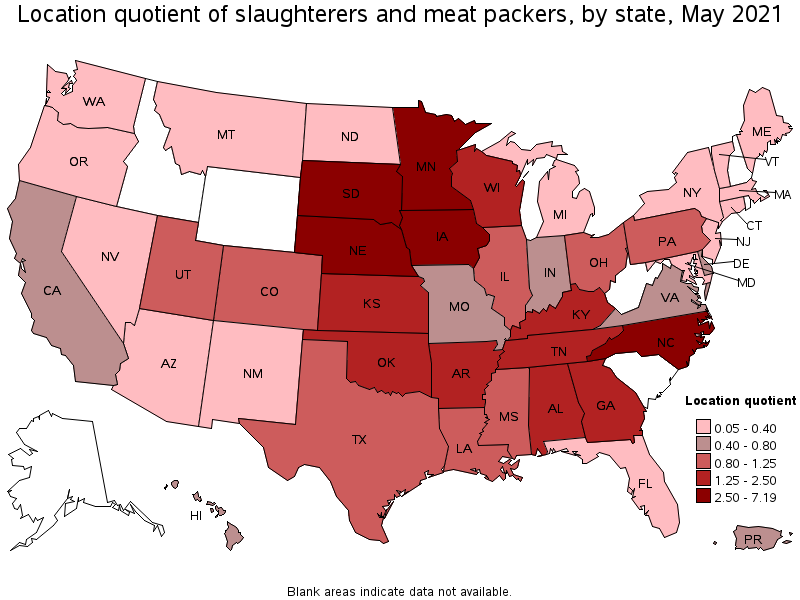
States with the highest concentration of jobs and location quotients in Slaughterers and Meat Packers:
| State | Employment (1) | Employment per thousand jobs | Location quotient (9) | Hourly mean wage | Annual mean wage (2) |
|---|---|---|---|---|---|
| Iowa | 6,550 | 4.41 | 7.19 | $ 16.89 | $ 35,140 |
| Nebraska | 2,880 | 3.01 | 4.90 | $ 16.26 | $ 33,820 |
| Minnesota | 6,860 | 2.51 | 4.09 | $ 15.90 | $ 33,080 |
| North Carolina | 10,200 | 2.31 | 3.76 | $ 15.45 | $ 32,130 |
| South Dakota | 840 | 1.98 | 3.23 | $ 16.92 | $ 35,190 |
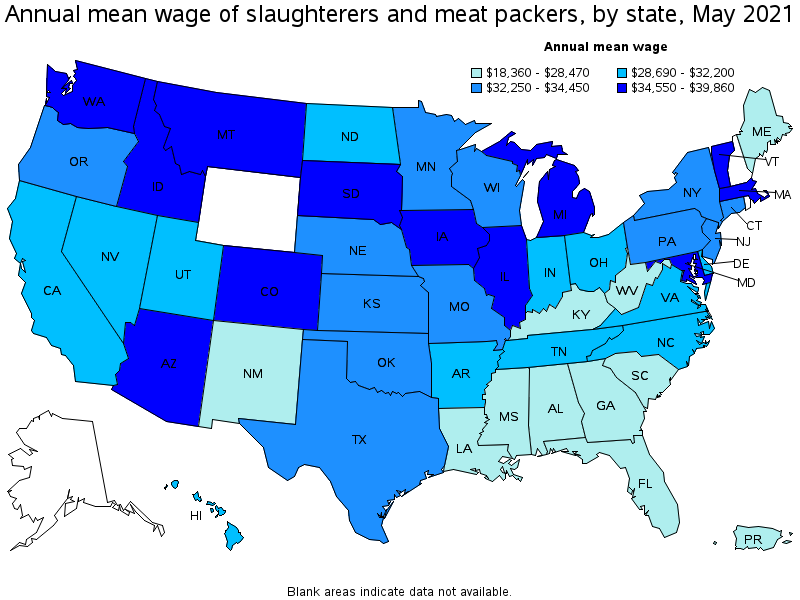
Top paying states for Slaughterers and Meat Packers:
| State | Employment (1) | Employment per thousand jobs | Location quotient (9) | Hourly mean wage | Annual mean wage (2) |
|---|---|---|---|---|---|
| Idaho | (8) | (8) | (8) | $ 19.17 | $ 39,860 |
| Arizona | 430 | 0.15 | 0.24 | $ 18.71 | $ 38,920 |
| Colorado | 1,990 | 0.76 | 1.24 | $ 18.58 | $ 38,650 |
| Michigan | 900 | 0.22 | 0.36 | $ 17.60 | $ 36,610 |
| Massachusetts | 110 | 0.03 | 0.05 | $ 17.34 | $ 36,060 |
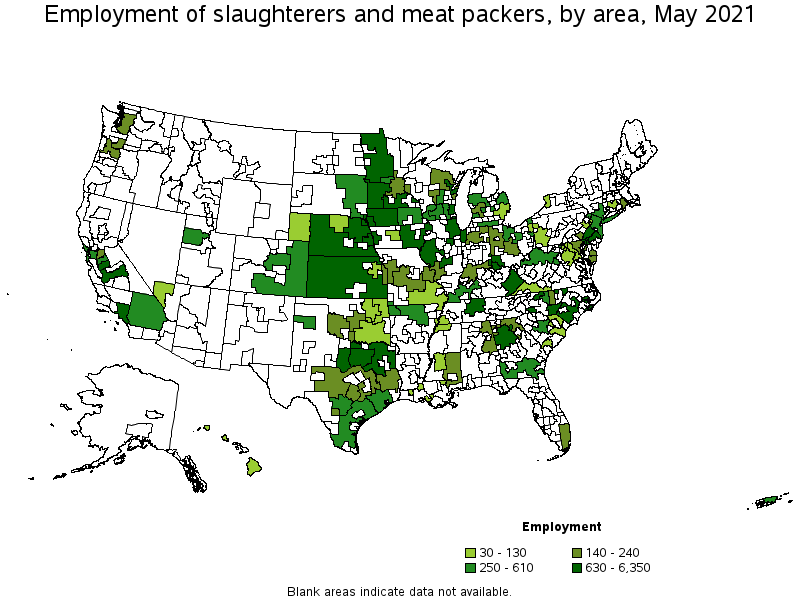
Metropolitan areas with the highest employment level in Slaughterers and Meat Packers:
| Metropolitan area | Employment (1) | Employment per thousand jobs | Location quotient (9) | Hourly mean wage | Annual mean wage (2) |
|---|---|---|---|---|---|
| Chicago-Naperville-Elgin, IL-IN-WI | 1,920 | 0.45 | 0.74 | $ 17.44 | $ 36,280 |
| Fresno, CA | 1,900 | 5.07 | 8.27 | $ 14.81 | $ 30,800 |
| Philadelphia-Camden-Wilmington, PA-NJ-DE-MD | 1,710 | 0.64 | 1.05 | $ 16.50 | $ 34,320 |
| Los Angeles-Long Beach-Anaheim, CA | 1,560 | 0.27 | 0.45 | $ 15.73 | $ 32,720 |
| Omaha-Council Bluffs, NE-IA | 920 | 1.98 | 3.23 | $ 16.25 | $ 33,800 |
| Sioux City, IA-NE-SD | 890 | 10.59 | 17.27 | $ 17.18 | $ 35,740 |
| Cincinnati, OH-KY-IN | 840 | 0.82 | 1.34 | $ 14.91 | $ 31,010 |
| Atlanta-Sandy Springs-Roswell, GA | 820 | 0.32 | 0.52 | $ 14.85 | $ 30,890 |
| Green Bay, WI | 790 | 4.78 | 7.79 | $ 15.44 | $ 32,110 |
| Milwaukee-Waukesha-West Allis, WI | 760 | 0.96 | 1.57 | $ 15.31 | $ 31,850 |
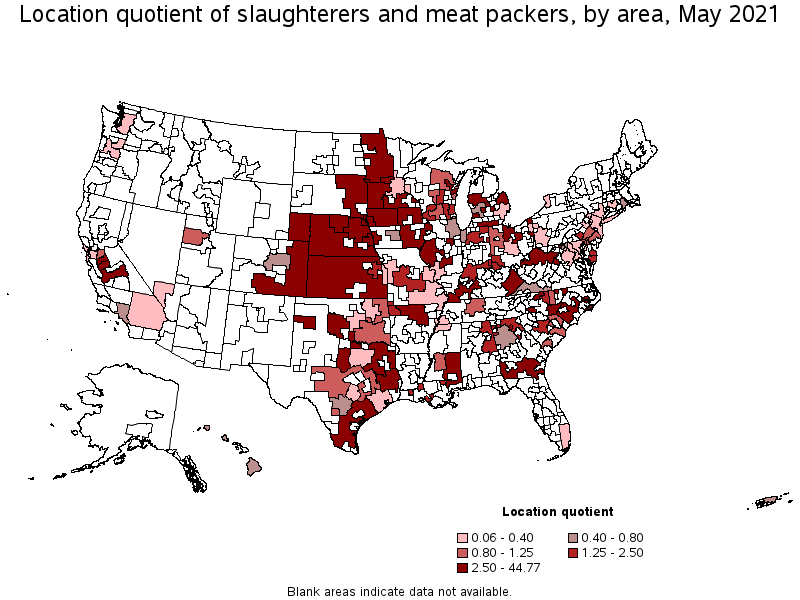
Metropolitan areas with the highest concentration of jobs and location quotients in Slaughterers and Meat Packers:
| Metropolitan area | Employment (1) | Employment per thousand jobs | Location quotient (9) | Hourly mean wage | Annual mean wage (2) |
|---|---|---|---|---|---|
| Sioux City, IA-NE-SD | 890 | 10.59 | 17.27 | $ 17.18 | $ 35,740 |
| Merced, CA | 640 | 8.84 | 14.41 | $ 14.46 | $ 30,070 |
| Gainesville, GA | 730 | 8.17 | 13.32 | $ 14.23 | $ 29,590 |
| Harrisonburg, VA | 370 | 6.04 | 9.85 | $ 14.65 | $ 30,480 |
| Fresno, CA | 1,900 | 5.07 | 8.27 | $ 14.81 | $ 30,800 |
| St. Cloud, MN | 470 | 4.82 | 7.86 | $ 16.98 | $ 35,320 |
| Green Bay, WI | 790 | 4.78 | 7.79 | $ 15.44 | $ 32,110 |
| Amarillo, TX | 270 | 2.34 | 3.81 | (8) | (8) |
| Modesto, CA | 390 | 2.14 | 3.48 | $ 14.54 | $ 30,230 |
| Omaha-Council Bluffs, NE-IA | 920 | 1.98 | 3.23 | $ 16.25 | $ 33,800 |
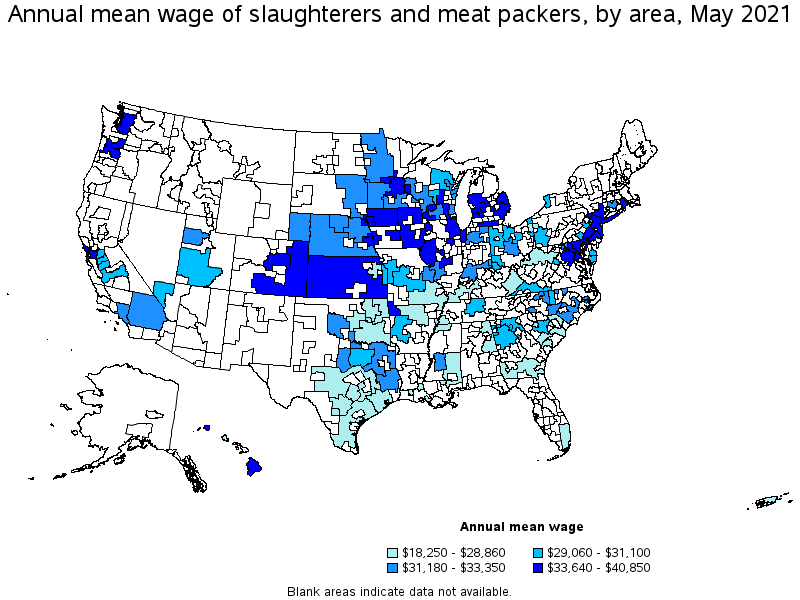
Top paying metropolitan areas for Slaughterers and Meat Packers:
| Metropolitan area | Employment (1) | Employment per thousand jobs | Location quotient (9) | Hourly mean wage | Annual mean wage (2) |
|---|---|---|---|---|---|
| Detroit-Warren-Dearborn, MI | 70 | 0.04 | 0.06 | $ 19.64 | $ 40,850 |
| Denver-Aurora-Lakewood, CO | 360 | 0.24 | 0.40 | $ 18.89 | $ 39,300 |
| Des Moines-West Des Moines, IA | 130 | 0.36 | 0.59 | $ 18.77 | $ 39,050 |
| Washington-Arlington-Alexandria, DC-VA-MD-WV | 110 | 0.04 | 0.06 | $ 18.50 | $ 38,470 |
| San Francisco-Oakland-Hayward, CA | 290 | 0.13 | 0.21 | $ 18.04 | $ 37,530 |
| Minneapolis-St. Paul-Bloomington, MN-WI | 140 | 0.08 | 0.12 | $ 18.00 | $ 37,440 |
| Providence-Warwick, RI-MA | 200 | 0.37 | 0.60 | $ 17.45 | $ 36,300 |
| Chicago-Naperville-Elgin, IL-IN-WI | 1,920 | 0.45 | 0.74 | $ 17.44 | $ 36,280 |
| Sioux City, IA-NE-SD | 890 | 10.59 | 17.27 | $ 17.18 | $ 35,740 |
| Baltimore-Columbia-Towson, MD | 160 | 0.13 | 0.21 | $ 17.16 | $ 35,700 |
Nonmetropolitan areas with the highest employment in Slaughterers and Meat Packers:
| Nonmetropolitan area | Employment (1) | Employment per thousand jobs | Location quotient (9) | Hourly mean wage | Annual mean wage (2) |
|---|---|---|---|---|---|
| Southeast Coastal North Carolina nonmetropolitan area | 6,350 | 26.45 | 43.10 | $ 15.82 | $ 32,910 |
| Southwest Minnesota nonmetropolitan area | 3,180 | 27.47 | 44.77 | $ 16.00 | $ 33,280 |
| Southeast Minnesota nonmetropolitan area | 2,070 | 13.95 | 22.73 | $ 15.62 | $ 32,480 |
| North Texas Region of Texas nonmetropolitan area | 1,420 | 5.36 | 8.73 | $ 15.81 | $ 32,880 |
| Northwest Iowa nonmetropolitan area | 1,370 | 10.49 | 17.10 | $ 16.96 | $ 35,270 |
Nonmetropolitan areas with the highest concentration of jobs and location quotients in Slaughterers and Meat Packers:
| Nonmetropolitan area | Employment (1) | Employment per thousand jobs | Location quotient (9) | Hourly mean wage | Annual mean wage (2) |
|---|---|---|---|---|---|
| Southwest Minnesota nonmetropolitan area | 3,180 | 27.47 | 44.77 | $ 16.00 | $ 33,280 |
| Southeast Coastal North Carolina nonmetropolitan area | 6,350 | 26.45 | 43.10 | $ 15.82 | $ 32,910 |
| Southeast Minnesota nonmetropolitan area | 2,070 | 13.95 | 22.73 | $ 15.62 | $ 32,480 |
| Northeast Nebraska nonmetropolitan area | 1,070 | 11.73 | 19.12 | $ 16.03 | $ 33,350 |
| Northwest Iowa nonmetropolitan area | 1,370 | 10.49 | 17.10 | $ 16.96 | $ 35,270 |
Top paying nonmetropolitan areas for Slaughterers and Meat Packers:
| Nonmetropolitan area | Employment (1) | Employment per thousand jobs | Location quotient (9) | Hourly mean wage | Annual mean wage (2) |
|---|---|---|---|---|---|
| Eastern and Southern Colorado nonmetropolitan area | 520 | 7.77 | 12.66 | $ 18.04 | $ 37,530 |
| Balance of Lower Peninsula of Michigan nonmetropolitan area | 560 | 2.23 | 3.63 | $ 17.91 | $ 37,250 |
| South Central Wisconsin nonmetropolitan area | 300 | 1.52 | 2.47 | $ 17.03 | $ 35,430 |
| Kansas nonmetropolitan area | 990 | 2.64 | 4.31 | $ 17.01 | $ 35,380 |
| Northeast Iowa nonmetropolitan area | 400 | 4.19 | 6.83 | $ 16.99 | $ 35,340 |
These estimates are calculated with data collected from employers in all industry sectors, all metropolitan and nonmetropolitan areas, and all states and the District of Columbia. The top employment and wage figures are provided above. The complete list is available in the downloadable XLS files.
The percentile wage estimate is the value of a wage below which a certain percent of workers fall. The median wage is the 50th percentile wage estimate—50 percent of workers earn less than the median and 50 percent of workers earn more than the median. More about percentile wages.
(1) Estimates for detailed occupations do not sum to the totals because the totals include occupations not shown separately. Estimates do not include self-employed workers.
(2) Annual wages have been calculated by multiplying the hourly mean wage by a "year-round, full-time" hours figure of 2,080 hours; for those occupations where there is not an hourly wage published, the annual wage has been directly calculated from the reported survey data.
(3) The relative standard error (RSE) is a measure of the reliability of a survey statistic. The smaller the relative standard error, the more precise the estimate.
(8) Estimate not released.
(9) The location quotient is the ratio of the area concentration of occupational employment to the national average concentration. A location quotient greater than one indicates the occupation has a higher share of employment than average, and a location quotient less than one indicates the occupation is less prevalent in the area than average.
Other OEWS estimates and related information:
May 2021 National Occupational Employment and Wage Estimates
May 2021 State Occupational Employment and Wage Estimates
May 2021 Metropolitan and Nonmetropolitan Area Occupational Employment and Wage Estimates
May 2021 National Industry-Specific Occupational Employment and Wage Estimates
Last Modified Date: March 31, 2022